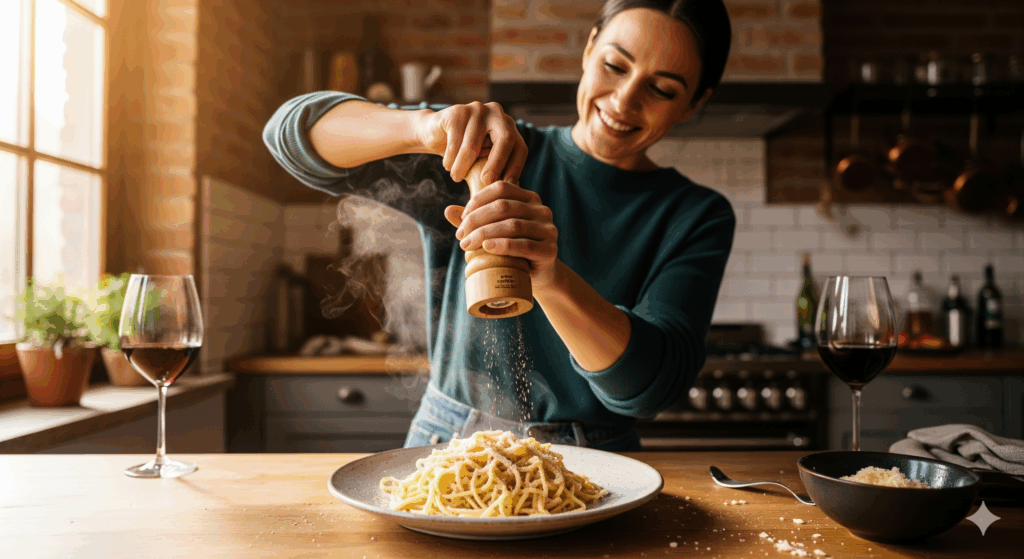I spent an entire year perfecting this creamy vegan cacio e pepe pasta recipe—and it was 100% worth it
The first time I made vegan cacio e pepe, it looked like someone had dumped cottage cheese on overcooked noodles. My partner took one bite, paused, and said “interesting texture choice.” We ordered pizza that night.
But here’s the thing about failure—sometimes it becomes an obsession. Traditional cacio e pepe already challenges even experienced cooks with its deceptively simple ingredient list. Making it vegan? That’s when you realize how much heavy lifting cheese actually does. Yet after 52 weeks of attempts (yes, I kept count), I finally cracked the code to a silky, peppery, impossibly creamy vegan version that would make a Roman grandmother pause mid-eye-roll.
The science nobody tells you about
Most vegan cacio e pepe recipes throw cashews at the problem and call it a day. While cashews create richness, they often mask the sharp, salty punch that defines this dish. The real challenge isn’t replacing cheese—it’s understanding emulsification. Traditional versions rely on pecorino’s specific fat-to-protein ratio mixing with starchy pasta water at exactly the right temperature. Too hot? Clumpy mess. Too cool? Nothing combines.
After diving deep into food science forums and even stumbling across research on pasta sauce emulsification, I discovered the secret lies in three elements: starch concentration, temperature control, and the right emulsifier. Once you understand these principles, you can create that glossy, clingy sauce without a blender in sight.
Why this version actually works
Instead of building a heavy cashew cream that drowns out the pepper’s bite, this recipe uses miso paste and nutritional yeast to mimic pecorino’s sharp, salty complexity. White miso specifically brings umami depth without the stronger flavor of red or brown varieties. But the real hero is the technique: creating a paste first with cold water—similar to making a roux—then combining it with concentrated pasta water at precisely the right temperature. This method gives you that magical sauce that clings to each strand like silk.
- 1 pound spaghetti bronze-cut grips sauce better, though any long pasta works
- 1 cup nutritional yeast finely ground
- 2 tablespoons white miso paste contains soy
- 2 tablespoons vegan butter
- 2 tablespoons whole black peppercorns
- 1 teaspoon cornstarch optional but recommended for beginners
- Salt for pasta water
- 2-3 tablespoons vegan parmesan for serving optional
Prep your mise en place
-
Place the nutritional yeast in a mortar and pestle and grind it into a fine powder—this prevents those little flakes that scream “health food store pasta.” Mix the ground nutritional yeast with the miso paste in a medium bowl. If using cornstarch (and honestly, just use it your first few times), whisk it with 2 tablespoons cold water until smooth and add to the yeast mixture. Set aside.
Toast the pepper
-
Heat a dry pan over medium heat. Add whole peppercorns and toast for 30-45 seconds until you can smell them—that aromatic moment when your kitchen smells like a Roman trattoria. Transfer to a mortar and pestle and crush coarsely. You want texture here, not dust.
-
Cook the pasta strategically
-
Here’s where most recipes fail you: fill a large pot with just enough water to cover the pasta by about 2 inches. Less water means more concentrated starch, which is your emulsification insurance policy. Salt it generously and bring to a boil.
-
Add pasta and cook for 2 minutes less than package directions (timing varies by brand—taste for firmness). Before draining, ladle out 2 cups of that starchy liquid gold. This isn’t just pasta water—it’s your sauce base.
The critical assembly
-
Drain the pasta and let it sit for exactly 30 seconds—this brings the temperature down from clumpy disaster zone to creamy sweet spot. Add the pasta back to the pot (off heat) with the vegan butter and crushed pepper. Toss for 30 seconds.
-
Now the magic: add 1/2 cup pasta water to your nutritional yeast mixture and whisk into a thick paste. Pour this over the pasta and toss vigorously, adding more pasta water a splash at a time until you get that glossy, clingy sauce that ribbons off the pasta when you lift it. The whole process should take about 90 seconds of continuous tossing—think of it as your pasta workout.
Serve immediately
-
And I mean immediately. This isn’t a dish that waits. Divide among bowls, hit it with more black pepper and vegan parm if using, and watch people’s faces change when they realize plants can do this.
For gluten-free, use brown rice or corn-based spaghetti—they release more starch than legume-based options, which helps the sauce emulsify.
Critical tips from my year of failures
The pasta water is everything. That concentrated starch acts as your emulsifier. If you used too much water to cook the pasta, your sauce will never come together properly.
Temperature matters more than you think. I started using an instant-read thermometer—optimal mixing temperature is between 160-175°F. Any hotter and the proteins clump; any cooler and nothing emulsifies.
Speed is your friend. Once you start combining, work fast and don’t stop tossing. Hesitation leads to separation.
The cornstarch hack. Purists will hate this, but a teaspoon of cornstarch guarantees success while you’re learning. Once you nail the technique, you can skip it.
Bronze-cut pasta makes a difference. The rougher surface grabs sauce better than smooth pasta, though both work.
Troubleshooting
If your sauce breaks: Remove from heat immediately, add a splash of cold water, and whisk vigorously. The temperature drop often brings it back together.
If it’s too thick: Add pasta water, not plain water. You need that starch.
If it lacks punch: You probably under-toasted the pepper or used pre-ground. Fresh-cracked, toasted peppercorns are non-negotiable.
Storage notes
Leftovers keep for 3-4 days refrigerated, though the texture won’t be quite the same. Reheat gently on the stovetop with a splash of plant milk or water, stirring constantly to re-emulsify. But honestly? This dish is best eaten standing at the stove, burning your tongue because you can’t wait.


